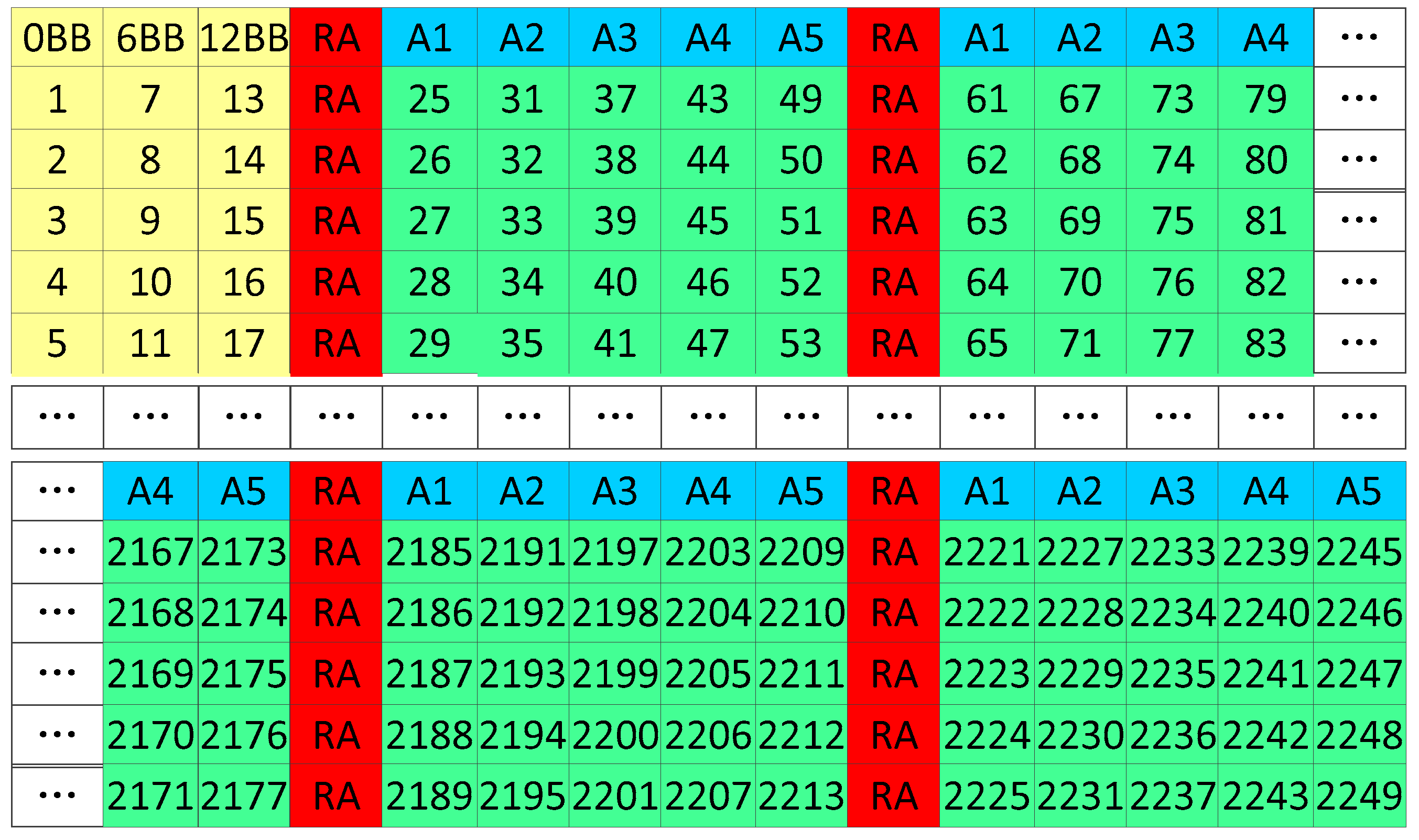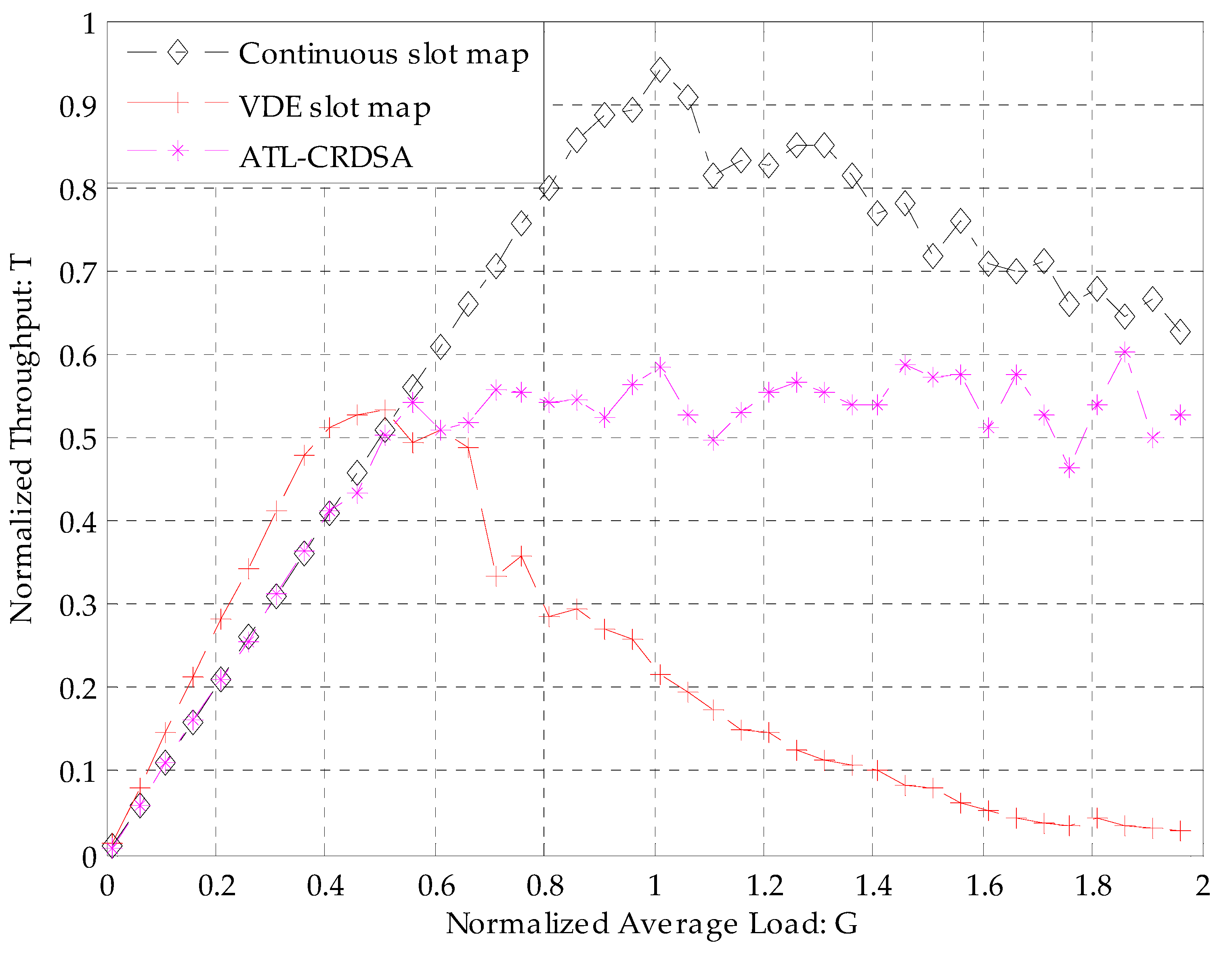A Novel Random Access Algorithm for Very High Frequency Data Exchange (VDE)
Abstract
1. Introduction
2. Related Work
3. Frame Structure, Slot Map and ATL-CRDSA
3.1. Frame Structure and Slot Map
3.1.1. Frame Structure
3.1.2. Slot Map
3.2. ATL-CRDSA Algorithm
3.2.1. CRDSA Contention Resolution
3.2.2. Traffic Load Control
4. Performance Evaluation
4.1. Normalized Throughput
4.2. Packet Collision Ratio
4.3. Packet Loss Ratio
4.4. ATL-CRDSA Throughput under Different Loads
5. Conclusions
Author Contributions
Funding
Conflicts of Interest
References
- International Telecommunication Union. Automatic Identification System VHF Data Link Loading; Report ITU-R M.2287-0; ITU: Geneva, Switzerland, 2013. [Google Scholar]
- Šafár, J.; Hargreaves, C.; Ward, N. The VHF data exchange system. In Antennas, Propagation RF Technology for Transport and Autonomous Platforms 2017; Curran Associates, Inc.: Red Hook, NY, USA, 2017; pp. 1–8. [Google Scholar]
- Kim, K.M.; Kim, Y.; Cho, Y.; Moon, K.; Lee, T.; Choi, S.; Kim, J.W. Performance Evaluation of Maritime VDES Networks with OPNET Simulator. In 2018 11th International Symposium on Communication Systems, Networks & Digital Signal Processing (CSNDSP); IEEE: Budapest, Hungary, 2018; pp. 1–6. [Google Scholar]
- International Telecommunication Union. Technical Characteristic for a VHF Data Exchange System in the VHF Maritime Mobile Band; Recommendation ITU-R M.2092-0+; ITU: Geneva, Switzerland, 2015. [Google Scholar]
- Clazzer, F.; Munari, A.; Giorgi, F. OCEANS 2017-Aberdeen. In Asynchronous Random Access Schemes for the VDES Satellite Uplink; IEEE: Aberdeen, UK, 2017; pp. 1–8. [Google Scholar]
- Yao, Z. Application and development trend of VDES communication technology. J. World Shipping 2019, 42, 34–38. [Google Scholar]
- Jia, D.; Fei, Z.; Xiao, M.; Cao, C.; Kuang, J. Enhanced frameless slotted ALOHA protocol with Markov chains analysis. J. Sci. Chin. (Inform. Sci.) 2018, 61, 187–197. [Google Scholar] [CrossRef]
- Abramson, N. The ALOHA system–another alternative for computer communications. J. Fall Joint Comput. Conf. 1977, 37, 281–285. [Google Scholar]
- Roberts, L.G. ALOHA packet systems with and without slots and capture. J.ACM SIGCOMM Comput. Commun. Rev. 1975, 5, 28–42. [Google Scholar] [CrossRef]
- Abramson, N. The throughput of packet broadcasting channels. IEEE Trans. Commun. 1977, 25, 117–128. [Google Scholar] [CrossRef]
- Mandal, P.; De, S. Stability of S-Aloha with variable propagation delay. IET Commun. 2019, 13, 1813–1820. [Google Scholar] [CrossRef]
- Polonelli, T.; Brunelli, D.; Benini, L. Slotted ALOHA Overlay on LoRaWAN—A Distributed Synchronization Approach. In 16th International Conference on Embedded and Ubiquitous Computing (EUC 2018); IEEE: Bucharest, Romania, 2018; pp. 129–132. [Google Scholar]
- Wu, H.; Zhu, C.; La, R.J.; Liu, X.; Zhang, Y. FASA: Accelerated S-ALOHA Using Access History for Event-Driven M2M Communications. IEEE/ACM Trans. Networking 2013, 21, 1904–1917. [Google Scholar] [CrossRef]
- Raychaudhuri, D. ALOHA with multipacket messages and ARQ-type retransmission protocols-throughput analysis. IEEE Trans. Commun. 1984, 32, 148–154. [Google Scholar] [CrossRef]
- Munari, A.; Heindlmaier, M.; Liva, G.; Berioli, M. The Throughput of Slotted Aloha with Diversity. In 2013 51st Allerton Annual Conference on Communications, Control and Computing (Allerton); IEEE: Monticello, IL, USA, 2013; pp. 698–706. [Google Scholar]
- Casini, E.; De Gaudenzi, R.; Del Rio Herrero, O. Contention Resolution Diversity Slotted ALOHA (CRDSA): An Enhanced Random Access Scheme for Satellite Access Packet Networks. IEEE Trans. Wireless Commun. 2007, 6, 1408–1419. [Google Scholar] [CrossRef]
- Mei, H.; Wang, H.; Shen, X.; Bai, W. An Adaptive MAC Protocol for Underwater Acoustic Sensor Networks with Dynamic Traffic. In OCEANS 2018 MTS/IEEE Charleston; IEEE: Charleston, SC, USA, 2018; pp. 1–4. [Google Scholar]
- Wang, G.; Zhong, X.; Mei, S.; Wang, J. An Adaptive Medium Access Control Mechanism for Cellular based Machine to Machine (M2M) Communication. In 2010 IEEE International Conference on Wireless Information Technology and Systems; IEEE: Honolulu, HI, USA, 2010; pp. 1–4. [Google Scholar]
- Ye, J. ALOHA-A kind of computer communication. Mobile Commun. 1990, 5, 7–8. [Google Scholar]
- Gotthardt, C. Throughput and backlog time in S-ALOHA multi-hop networks. In IEEE 39th Vehicular Technology Conference; IEEE: San Francisco, CA, USA, USA, 1989; pp. 799–803. [Google Scholar]
- Rivero-Angeles, M.E.; Lara-Rodriguez, D.; Cruz-Perez, F.A. Performance evaluation of EDGE under S-ALOHA and adaptive traffic load S-ALOHA random access protocols. In 2004 IEEE 59th Vehicular Technology Conference. VTC 2004-Spring (IEEE Cat. No.04CH37514); IEEE: Milan, Italy, 2004; pp. 2291–2295. [Google Scholar]
- Seo, J.; Jin, H.; Leung, V.C.M. Impacts of Retransmission Limit on Stability and Throughput Regions of S-ALOHA Systems. IEEE Trans. Veh. Technol. 2017, 66, 10296–10306. [Google Scholar] [CrossRef]
- Liva, G. Graph-based analysis and optimization of contention resolution diversity slotted ALOHA. IEEE Trans. Commun. 2011, 59, 477–487. [Google Scholar] [CrossRef]
- Kissling, C. Performance enhancements for asynchronous random access protocols over satellite. In IEEE International Conference on Communications (ICC); IEEE: Kyoto, Japan, 2011; pp. 1–6. [Google Scholar]
- Clazzer, F.; Kissling, C. Enhanced contention resolution ALOHA—ECRA. Available online: http://arxiv.org/abs/1211.5027 (accessed on 20 January 2019).
- Zheng, L.; Cai, L. AFDA: Asynchronous Flipped Diversity ALOHA for Emerging Wireless Networks with Long and Heterogeneous Delay. IEEE Trans. Emerging Top. Comput. 2014, 3, 64–73. [Google Scholar] [CrossRef]
- International Association of Marine Aids to Navigation and Lighthouse Authorities. Technical Specification of VDES, 3rd ed.; IALA: St Germain-en-Laye, France, 2019. [Google Scholar]
- Rivero-Angeles, M.E.; Lara-Rodriguez, D.; Cruz-Perez, F.A. Random-access control mechanisms using adaptive traffic load in ALOHA and CSMA strategies for EDGE. IEEE Trans. Veh. Technol. 2005, 54, 1160–1186. [Google Scholar] [CrossRef]
- Rivero-Angeles, M.E.; Lara-Rodriguez, D.; Cruz-Perez, F.A. A new EDGE medium access control mechanism using adaptive traffic load slotted ALOHA. In IEEE 54th Vehicular Technology Conference. VTC Fall 2001. Proceedings (Cat. No.01CH37211); IEEE: Atlantic City, NJ, USA, 2001; pp. 1358–1362. [Google Scholar]









© 2020 by the authors. Licensee MDPI, Basel, Switzerland. This article is an open access article distributed under the terms and conditions of the Creative Commons Attribution (CC BY) license (http://creativecommons.org/licenses/by/4.0/).
Share and Cite
Jiang, Y.; Zheng, Y.; Wang, J. A Novel Random Access Algorithm for Very High Frequency Data Exchange (VDE). J. Mar. Sci. Eng. 2020, 8, 83. https://doi.org/10.3390/jmse8020083
Jiang Y, Zheng Y, Wang J. A Novel Random Access Algorithm for Very High Frequency Data Exchange (VDE). Journal of Marine Science and Engineering. 2020; 8(2):83. https://doi.org/10.3390/jmse8020083
Chicago/Turabian StyleJiang, Yi, Yang Zheng, and Junsen Wang. 2020. "A Novel Random Access Algorithm for Very High Frequency Data Exchange (VDE)" Journal of Marine Science and Engineering 8, no. 2: 83. https://doi.org/10.3390/jmse8020083
APA StyleJiang, Y., Zheng, Y., & Wang, J. (2020). A Novel Random Access Algorithm for Very High Frequency Data Exchange (VDE). Journal of Marine Science and Engineering, 8(2), 83. https://doi.org/10.3390/jmse8020083




